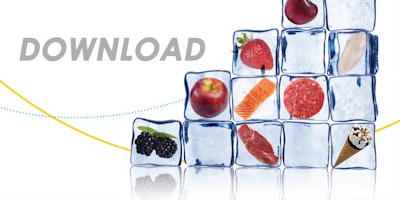
Thinking Outside
the Liquid Nitrogen Freezing Box
Liquid nitrogen can improve your food
manufacturing operation in ways you may
have never even considered.
Brought to you by Air Products.
Over 75 years of cryogenic food
freezing innovations.
1Introduction 2
Overview 3
Injection Cooling of Meat 4
Injection Cooling of Sauces 6
Machine Component Cooling 8
Food-Surface Cooling 10
Conclusion 12
Contents
Liquid nitrogen can be
used as an ultra cold gas at
temperatures as low as –265˚ F.
Perfect for quick freezing or
chilling.
| Contents
For more than a half-century, liquid nitrogen has been used to
freeze and chill food products. In the food industry, liquid nitrogen
is most commonly used to power tunnel or spiral freezers for
the final preservation of food before it is packaged and shipped
around the country. Capitalizing on liquid nitrogen’s extraordinary
refrigeration properties, food manufacturers use liquid nitrogen
freezers to increase throughput and improve product quality. While
final product freezing with liquid nitrogen remains a common
process, liquid nitrogen is moving upstream in the production
process, where its application is providing added benefits for food
manufacturers.
Thinking outside of the “liquid nitrogen freezing” box has led to
even more innovative ways of using nitrogen throughout the food
production process. The following pages share unique ways food
manufacturers are using nitrogen to improve both the quality of
their products and the efficiency of their operations.
Introduction
2 | Introduction
3Today, liquid nitrogen is being used to remove troublesome heat from food
processes up and down the production line, thereby increasing production
throughput, reducing cycle times, and even helping to prevent microbial
growth. In mixing applications, liquid nitrogen is used to instantly stop the
cooking process in order to chill sauces and gravies, ultimately reducing
cooling times. In coating applications, the low temperature of liquid
nitrogen provides greater control of the enrobing process. And during
grinding, liquid nitrogen can be used to eliminate frictional heat to help
improve the throughput of mills and the consistency of the grind. This also
helps to prevent the loss of flavor and aroma components in food additives,
ingredients, and functional foods.
Overview
Liquid nitrogen can improve
your food manufacturing
operation in ways you may
have never even considered.
| Overview
4Direct food cooling targets liquid nitrogen at the food product. Almost
all processed foods require cooling at some point in the process prior
to packaging and shipment. For example, high capacity meat forming
machines are used to deliver the great demand for burgers and other
formed products. However, the heat generated by mixing and grinding
can melt the fats, making subsequent forming of the meat product quite
difficult.
Injection Cooling of Meat with Liquid Nitrogen
Ultra cold liquid nitrogen
cools very efficiently. Nitrogen
injection systems can use
the same or less amount of
cryogen than comparable CO2
systems thus representing a
cost effective gas alternative.
| Injection Cooling of Meat with Liquid Nitrogen
5A producer of hamburger patties was having
daily processing complications due to the
highly variable mix of fresh and frozen beef
cuts available for use in their patty forming
operation. The hamburger patty producer had
to be sure that the proper portions of fresh and
frozen cuts were on hand in order to create
their high-quality ground product. If no frozen
cuts were available, or there was an insufficient
amount, either the production run was cut short
or the quality of the patties was diminished.
However, by adding liquid nitrogen injection—
with a special control system—to their mixer,
the hamburger patty producer was able to
create ground beef patties at consistently low
temperatures.
Applying liquid nitrogen directly to a food
product using a proper injection system ensures
repeatable and consistent products for forming.
This solution is also suitable for fish, chicken,
pork and many other products.
Liquid nitrogen can be used to help maintain
the cold temperature of the meat through a
controlled injection directly into the product
during mixing/grinding. The nitrogen injection
is regulated to provide the cold that is required
at all times, adjusting the liquid nitrogen
consumption to the requirements of the process.
Injecting liquid nitrogen during processing
improves the quality of the ground meat as the
fat is not broken up, and the cuts are regular
and even. Additionally, the mixes are more even,
as the time taken to make them does not need
to be shortened as the temperature increases;
bacteria are inhibited by changing the contact
atmosphere of the meat (eliminating oxygen);
and the appearance of the meat is improved by
avoiding the formation of metmyoglobin, which
results from excessive exposure to the oxygen in
air.
| Injection Cooling of Meat with Liquid Nitrogen
6Injection Cooling of Sauces with Liquid Nitrogen
Liquid nitrogen can be directly injected into flowing liquids for practically
immediate cooling. Almost any product that is able to be pumped—such as
sauces, gravies, marinades, custards and purees—can be chilled in-process.
Typically, liquid food cooling is accomplished using relatively large scraped
surface heat exchangers (continuous) or in-kettle cooling (batch). By using
liquid nitrogen injection, liquid foods can be cooled from nearly boiling
temperatures to packaging temperatures in just seconds.
Applying liquid nitrogen
directly to a food product
using an injection-cooling
system ensures repeatable
and consistent products for
forming or further processing.
This solution is suitable
for soups, sauces, mixed
vegetables, fish and chicken.
| Injection Cooling of Sauces with Liquid Nitrogen
7One food manufacturer was experiencing a host
of problems when trying to add a hot, cooked
sauce to what would ultimately become a frozen
meal. Problems included:
• Continued cooking of the sauce and other
ingredients
• Moisture migration from the sauce to other
ingredients in the meal
• A relatively time-consuming final freeze.
By installing a system that directly injects
liquid nitrogen into the hot sauce, the food
manufacturer was able to cool the sauce before
adding it to the meal, with no delay in the
process. The injection cooling system halted
cooking and moisture migration, as well as
shortened final freezing time, improving the
quality of the product.
| Injection Cooling of Sauces with Liquid Nitrogen
8Machine component cooling targets extremely cold nitrogen gas at heat-
generating parts in a food production process. Chilling knives, blades
and other fixtures during operation decreases product build-up on these
appliances, helping food processors avoid a bottleneck in their operations.
In addition to increased throughput, this application also eases clean-up
and can inhibit mold growth.
Machine Component Cooling with Liquid Nitrogen
Precision cooling can be a
perfect solution for machine-
component or food surface
cooling applications. It directly
targets cold nitrogen precisely
where needed, whether it’s
knives/blades/fixtures or
directly on food spots or
surfaces.
| Machine Component Cooling with Liquid Nitrogen
9Targeting nitrogen at machine components can
alleviate problems such as caramel sticking to
cutting blades; ice cream sticking to forming
molds; dough sticking to chopping knives; or
product adhesion in a bowl, chopper, grinding
mill, slicing machine or mixer.
For example, an ingredient producer mincing
a very sticky product was having trouble with
the product building up on the rotating blades
and scrapers. This would require the producer
to shutdown the operation every hour so the
blades could be cleaned. To address this problem,
a system was installed that targeted very
cold nitrogen gas at the blades well inside the
machinery. Cooling the blades prevented product
build-up, enabling the ingredient producer to
eliminate waste and unnecessary downtime.
Nozzles can be contorted, arranged and pointed
at just about any internal or external machine
fixture. Multiple nozzles can be incorporated to
ensure that targeted cooling hits every blade in
a fine mincing machine, or a single nozzle can be
used to cool a particular hot spot.
| Machine Component Cooling with Liquid Nitrogen
10
Food-surface cooling targets extremely cold nitrogen gas at the specific
spot, point or surface of food that requires heat removal. This type of
cooling can alleviate tricky processing problems where heat may create an
issue, such as sticking, clogging or jamming. Surface cooling can also add
speed and ease to layering steps or prevent the mixing of two different food
items.
Food-Surface Cooling with Liquid Nitrogen
Precision cooling systems
spray nitrogen with pin-point
accuracy utilizing a wide range
of flow rates and temperatures
to alleviate tricky processing
where heat may create an issue
like sticking, clogging,
or jamming.
| Food Surface Cooling with Liquid Nitrogen
11
Cooling food surfaces with nitrogen can help
alleviate issues with taffy cooling, product
layering, die jamming, fixture handling or
sticking, and much more. When a decorative
drizzle turns into a puddle or a seven layer cake
looks like three, targeting very cold nitrogen gas
at the problem area might be the solution.
Liquid nitrogen systems are relatively small due
to the extraordinarily cold temperature of liquid
nitrogen and the high energy that it carries, often
enabling them to fit into locations where other
solutions are impossible.
This worked particularly well for an ice cream
producer that needed to solidify a topping on a
manufactured cone product before packaging.
With very limited space available, a system could
be installed that targeted cold nitrogen gas at the
topping, providing the cooling needed to harden
the topping and ready the cone for packaging.
| Food Surface Cooling with Liquid Nitrogen
With a little innovation and ingenuity, and some out of the box
thinking, the benefits of nitrogen cooling in food processing
applications seem endless. An industrial gas supplier with strong
technical know-how and solid industry experience can evaluate
a food manufacturer’s operation and help uncover areas where
nitrogen cooling can be advantageous… perhaps in ways you may
have never even thought!
Conclusion
12 | Conclusion
For more information ,
please contact us at:
Corporate Headquarters
Air Products and Chemicals, Inc.
7201 Hamilton Boulevard
Allentown, PA 18195-1501
T 800-654-4567
F 800-272-4449
[email protected]
or visit airproducts.com/food
© Air Products and Chemicals, Inc., 2018 (41470) 352-18-010-US
tell me more
airproducts.com/food
For over 75 years Air Products team of food experts have worked with processors to show
how our gas and equipment solutions can improve food production processes.
Air Products’ Freshline offerings provide innovative freezing and preservation systems
to the food industry that not only enhance product quality, but are also designed to help
increase production rates and capacity plus improve yields with less waste. All this adds up
to lower costs and a more efficient system.
Air Products supplies a full line of Freshline liquid nitrogen and CO2 freezing systems that
can be tailored to meet your specific needs. Our tunnel and immersion freezers can freeze
a wide variety of foods, including raw, cooked, marinated, and breaded products. All of our
freezing systems use our cryogenics, which provides the most efficient means of freezing
and cooling available.
Air Products also provides engineering and services, including a state-of-the-art food
lab for testing a customer’s product on commercial-scale equipment to determine the
feasibility of using cryogenic freezing or chilling for their specific process, as well as on-site
testing capability and processing audits to reduce cryogen consumption.
About Air Products






















